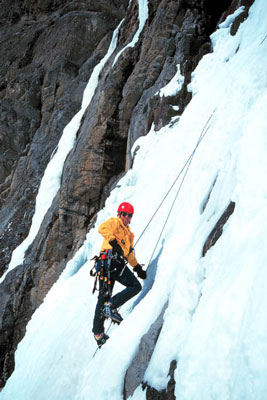 ;
;
;
;
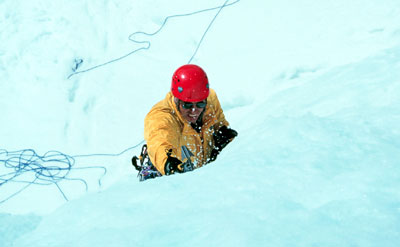
ICE EXTREMES
by Phil Maranda
If there was only one outdoor adventure sport on the planet that put
the “E” in extreme, it would have to be ice climbing. Not just on a
man-made wall, mind you, but on the frozen waterfalls that cascade in some
cases over a thousand feet and beyond down some of the highest peaks in the
Canadian Rockies.
Ice climbers in such an environment are constantly at risk and forced
with each ascent to battle the elements and their own psyche—so they don’t
freak out during the climb—facing the harsh reality that one mishap can send
them plummeting earthward. True, ice climbing is not for the faint-hearted; in
fact, most people probably think strapping on razor-sharp ice tools and
scaling hundreds of feet of vertical, frozen H2O is like totally insane. Who
knows, maybe they’re right!
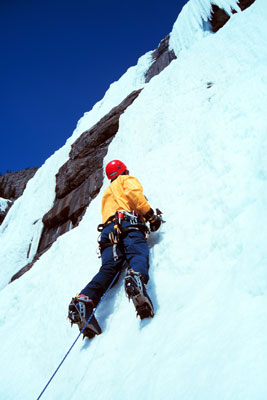
Ice
climbing, like most outdoor-adventure sports, presented a unique challenge
when it came to making the images. The first consideration, from a
photographic point of view, was trying to get the exposure right while
surrounded by ice and bright sunny conditions on day one. The next most
challenging aspect of the shoot was the vertical environment. There was no
easy way to carry
a large amount of gear up a sheer wall of ice.
To help overcome the first two challenges,
I spent a lot of time beforehand trying to best guess what I’d need to make
the images under the conditions mentioned above. I found that doing a little
research helped me to better judge what I’d need to carry while ice
climbing. I ended up reading a few books on ice climbing, going on the
Internet, and consulting my guide before I ever met him in the 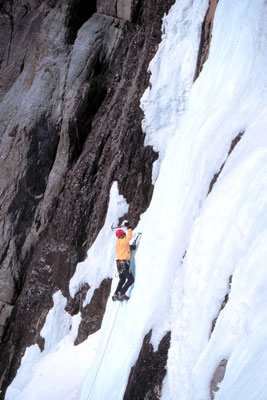
I chose one lens for the first day, and
that was a Nikon 28-70 mm 3.5-4.5D along with one compact yet rugged body that
I had at the time, a Nikon F90X. This combination had proved its worth in past
assignments, and so I felt it was the best choice
out of the gear I possessed. Once I had the camera and lens picked out, I
chose a small camera waist-pack that would hold the two items and the film and
filters I’d need.
Day one, I stuffed two rolls of Fuji Provia 100 and two rolls of Kodak E100SW into the bag along with a B+W circular polarizer filter. The filter helped to cut down on some of the glare, brought out the colors in the bright sunlight, and made the sky look even bluer than it already was. Along with the Nikon F90X and 28-70 mm lens, that was all I used to get the shots on the first day
I arrived at the Sunwapta ranger station in
The video was all it took to throw me into a slight panic. I’d been
afraid, more like terrified, of heights my whole life—well not really
heights but falling off of a cliff and smashing my body into pieces upon
reaching the ground. So I did the only thing I could under the circumstances
and asked a stupid question like, “What happens if you fall?” McKay
replied that if you make a serious mistake on an ice climb, like severing your
rope with an axe or crampon, and end up falling, it’s usually over. Not too
many people survive serious ice climbing accidents.
Sensing my apprehension, McKay quickly led me downstairs to pick out
the equipment we would need for our upcoming climb. He threw me a one-piece
climbing suit to try on. Then he produced a helmet, plastic climbing boots,
crampons, and a pair of razor-sharp ice axes that looked to me more like
weapons from a Bruce Lee movie than tools for climbing on ice.
Before long we were headed down the
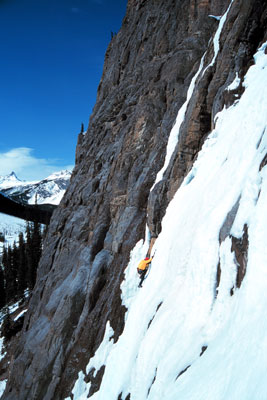
To
work out the exposure problem, I took spot-meter readings off my guide, the
little bit of rock that was exposed, and the ice. Then after deciding that the
ice would take up most of the photos, I used the exposure compensation on the
camera, setting it at +1EV initially and bracketing back and forth from there.
In conditions like that, I’ve found the best thing to do is to try many
combinations of exposures and hope that you’ll get some right.
Most of the pictures were taken while I was
anchored into the ice at 100 feet or so above the ground. Three ice screws
held me in place and allowed me to lean out and shoot down the wall
vertically. Joe McKay was very accommodating and climbed around on the wall
while I shot pictures of him.
The camera performed flawlessly and
wasn’t affected by the cold or adverse conditions. The trick I used in
getting sharp images came from holding the camera comfortably but firmly in
place, and when clicking the shutter I made sure it was during a period of
time when I wasn’t shaking too much from fear or exertion. Those times where
few and far between, allowing me few opportunities to actually shoot pictures.
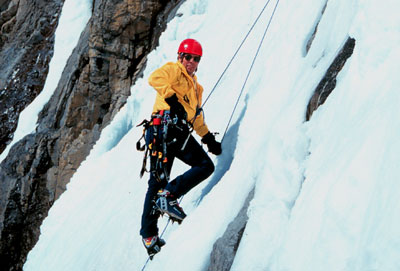
(I try to always use auto focus when
shooting on outdoor-adventure assignments. I also carry a spare camera, but in
this case it was down below and would have had to been retrieved if the F90X
messed up.)
Day two was pretty much the same only the
sky was overcast with a thin layer of clouds providing a natural filter. The
ice didn’t possess the extreme glare that it did the first day, so I mostly
metered off McKay, didn’t use the polarizer, kept the sky out of the
pictures whenever possible, and in my opinion, didn’t get nearly as dynamic
images as on the first day.
It was mid-afternoon when we arrived at the pullout below the Weeping
Wall. Grabbing the gear out of my Jeep, we began the hike to the base. The sun
was shining, the sky was a rich cobalt blue, and as we gained elevation on the
hump to the ice, I could see for miles in all directions. The snow and ice
fields on the mountain peaks glimmered, painting a most beautiful picture.
Overall it seemed like a good day to die.
When we reached the wall, McKay helped me into my harness and then gave
me a lesson on the art of climbing on ice. He described, while demonstrating,
the correct way of swinging the ice axe. “Bring it back over your shoulder,
but not too far, and then as you swing the tool forward, let your wrist
release, and the axe will place properly into the ice without you smashing
your hands,” he said. We then talked about the type of rope we’d be using,
kicking the crampons into the ice, and the belaying process before we geared
up and moved over to the wall.
The ice axes and crampons are sharp, dangerous tools and are just as
likely to end a climber’s life during a fall as actually hitting the ground.
That is probably one of the reasons why out of the millions of North Americans
who participate in climbing, only about five percent venture into the world of
climbing on ice.
“Remember to keep your heels flat when you kick the toe of the
crampon into the ice,” McKay said as he started upward. Then with the
dexterity of a seasoned ice jock, he climbed—while I belayed out the rope—with
seemingly little effort towards a small ridge. McKay reached the ridge (bulge)
that was located halfway up the first pitch in minutes, took a couple of ice
screws from his harness and began screwing them into the hard surface. He then
anchored himself into the wall by clipping the rope through a
carabiner he had attached to the ice screws, and then called down that
it was my turn to tackle the Weeping Wall. I’d always thought that there was
no way I’d ever climb a large rock wall, so the idea of scaling a vertical
sheet of ice was sending a chill up my spine that could only be matched by
standing naked at the North Pole in January.
Following a few last minute instructions shouted down from McKay, I
moved to the wall, drew back the ice axe in my right hand, and gave it hell.
My first swing was clumsy to say the least. The axe barely made a dint in the
hard surface, but I did manage to avoid rapping my knuckles. I had to try
again; there was no way the axe would hold. My next swing came from the heart,
but once again my technique sucked, and that caused me to smash my knuckles on
the wall. The axe, however, was finally secured enough to hold my weight, and
I kicked my crampon-clad boot into the ice and began to lift off from the
safety of the earth. Despite the bulges and pockmarks, the ice was like a
vertical skating rink—hard, cold and completely unforgiving—on which I
wouldn’t have been able to move without the highly specialized climbing
tools.
Trying to apply the techniques McKay had taught me, I scratched and
crawled my way up to the narrow ridge in what seemed like an hour’s time.
Throughout my ascent, the crampons on my boots kept releasing from the ice
simply because my heels were not down, and my axe swings, although improving,
still needed serious work. It was amazing how little fear I actually felt
though—me, a person who’d freaked severely on an indoor climbing wall
years earlier during a beginner’s climbing course. Looking back now, I think
it was the sheer concentration that ice climbing demands of its practitioners
that kept me from experiencing utter panic.
Reaching McKay’s position, I looked out over the mountains from my
lofty view while my guide made sure I was anchored into the ice by three ice
screws. After watching him descend and then climb back up the wall,
demonstrating more ice climbing techniques, it was time to leave. Following a
brief explanation of how he was going to belay me to the ground, I leaned back
in the harness, and he began lowering me while I walked slowly backwards down
the wall.
Next day, we arrived at
Once again my skills lacked the smoothness of years on the ice as I
slowly made my way up
From the top of the first pitch, we made our way along a sloping sheet
of ice that craned upward to where the second pitch began. McKay, sensing my
apprehension about climbing any higher, decided that we’d gone far enough
for the day and that we’d make our way just a little farther up to a spot
where he could belay me back down to the ground.
When we were near the belaying site, McKay demonstrated a few more
techniques by climbing around on a pillar of hanging icicles. He once again
showed me how to place the crampons and ice axes properly. “I never work
from a poor placement,” he said. “I keep banging away at the ice until the
axes and/or crampons are secured. If you don’t feel comfortable with your
placements, it is very difficult to have the confidence to move on.”
Once it was time to leave, my guide and I moved over to a cliff
located on one side of the falls where he’d belay me to the ground. He said
he was going to use two ropes just in case one of them got severed from the
sharp rocks at the top. All I could think about was if one rope could be cut,
what would keep the same thing from happening to the second one? Just as I was
about to verbalize my thoughts, McKay said, “Don’t worry, I won’t let
you fall. It’s a long walk for me back to
Being lowered over the 100-plus foot cliff turned out to be the
most terrifying experience of my whole ice climbing adventure. I had to keep
walking backwards towards the edge until there was simply no more surface.
Following McKay’s instruction, I leaned back, hung onto the rope for dear
life, and tried in vain to not look down. The ropes never did end up breaking,
but I did manage to smash various parts of my body on the rocks before making
it to the bottom.
When we finally packed up and were about to make the hump to the Jeep,
I was relieved to be back on the ground and felt a slight pang of pride at
somewhat conquering a life-long fear. At the same time I was disappointed that
my ice climbing adventure had come to an end. To this day, I still believe
that ice climbing is reserved for those with intense vertical courage. But are
they insane? Maybe not!